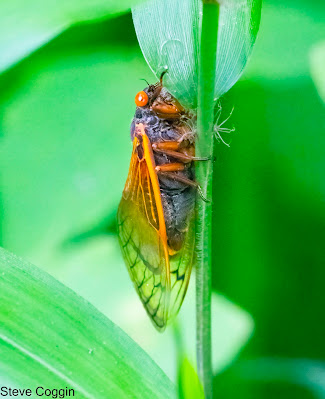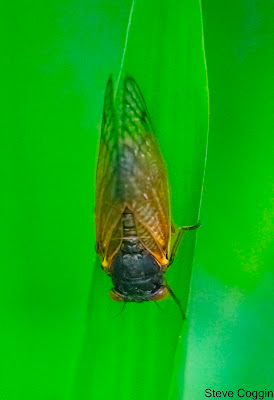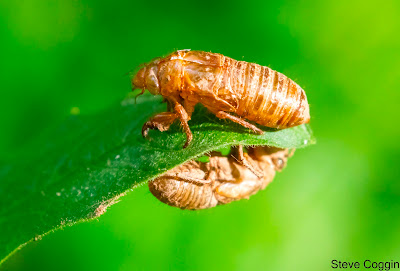 |
| Adult Periodical Cicada (Magicicada tredecim) on the morning of its emergence. Mecklenburg County, North Carolina |
The eastern United States are abuzz with the coming of Cicada Brood XIX. This spring, Periodical Cicadas (Magicicada sp.) are emerging from their 13-year underground sojourn as nymphs for a few brief weeks as large flying, mating and buzzing insects. There are 15 different broods of Periodical Cicadas, and all are found in Eastern North America.
 |
| Adult Periodical Cicada. Mecklenburg County, North Carolina. |
Periodical Cicadas have the longest life cycles any insects. Some take 17 years to mature but this year, in the south we have13-year cidadas. The genus Magicicada is composed of 7 species. Brood XIX is made up of billions of Magicicada tredecim, Magicicada tredecassini, Magicicada tredecula and Magicicada neotridecim. This is known as the Great Southern Brood and it ranges from North Carolina to Missouri although their distribution is quite spotty. This spring there are no Periodical Cicadas near our home in Rowan County, North Carolina, but they are abundant in some areas of Mecklenburg County, a mere 45 miles away.
 |
| Periodical Cicada. Mecklenburg County, North Carolina. |
Adult Periodical Cicadas are over an inch long, with red eyes, black bodies and translucent orange veined wings. Males have a sound generating organ on the abdomen called the tymbal. They vibrate the tymbal to produce a buzzing roar that can reach 100 decibels. This wall of sound produced by the males attracts females and they mate. The females cut small holes in tree twigs and lay their fertilized eggs in the stems. These eggs hatch to produce nymphs, the first larval stage of the Periodical Cicada. Nymphs drop to the ground and continue their development, feeding on sap from plant roots, growing and molting into larger nymphs. This process continues for 13 years and during this time the cicadas can neither fly nor mate.
 |
| Adult Periodical Cicada with two empty nymph exoskeletons. Mecklenburg County, North Carolina. |
Then the Periodical Cicadas begin to emerge. The fifth nymph stage digs tunnels through the soil and crawls up tree trunks, shrubs and even stout grasses. The back of the nymph exoskeleton splits, and the winged adult crawls out. Over the course of a couple of hours the cicadas pump fluid to expand their wings to their full size and their exoskeleton hardens. Then the Periodical Cicadas fly off to complete their life cycle.
 |
| Adult Periodical Cicada with its nymph exoskeleton. Mecklenburg County, North Carolina. |
 |
| Two empty nymph exoskeletons. Mecklenburg County, North Carolina. |
Periodical Cicadas emerge in vast numbers, over a million per acre in some places. All these cicadas emerging at the same time overwhelm their predators who cannot cause a significant dent in their numbers. The question of why Periodical Cicadas have 13 or 17-year life cycles has puzzled scientists for years. Of particular interest is 13 and 17 are prime numbers.
 |
| An empty nymph exoskeleton. Mecklenburg County, North Carolina. |
The spectacle of the Periodical Cicadas will continue for a
few more weeks and by mid-summer the adults will be gone. But the nymphs of Brood XIX will begin their long wait
underground and emerge again in 2037.
No comments:
Post a Comment